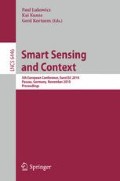Abstract
We investigate the use of magnetic field disturbances as features for motion based, wearable activity recognition systems. Such disturbances are mostly caused by large metallic objects and electrical appliances, both of which are often involved in human activities. We propose to detect them by subtracting angular velocity values computed from the changes in the magnetic field vector from gyroscope signals. We argue that for activities that are associated with specific objects or devices such features increase system robustness against motion variations, sensor displacement and inter user differences. On a previously published data set of 8 gym exercises we demonstrate that our approach can improve the recognition by up to 31% over gyroscope only and up to 17% over a combination of a gyroscope and 3D accelerometer. Improvements of 9.5% are also demonstrated for user independent training as well as for the case of displaced sensors.
A particularly interesting result is the fact that adding the magnetic disturbance features significantly improves recognition based on the vector norm of accelerometers and gyroscopes. The norm is often used when the orientation of the sensor is not known. This is common when using a mobile phone or other consumer appliance as a sensor.
Access this chapter
Tax calculation will be finalised at checkout
Purchases are for personal use only
Preview
Unable to display preview. Download preview PDF.
References
Amft, O., Bannach, D., Pirkl, G., Kreil, M., Lukowicz, P.: Towards wearable sensing-based assessment of fluid intake. In: 8th IEEE International Conference on Pervasive Computing and Communications Workshops (PERCOM Workshops), pp. 298–303 (2010)
Benbasat, A., Paradiso, J.: An inertial measurement framework for gesture recognition and applications. Gesture and Sign Language in Human- (January 2002)
Fels, S., Lyons, M.: Creating new interfaces for musical expression: introduction to nime. In: SIGGRAPH 2009: SIGGRAPH 2009 Courses (August 2009)
Förster, K., Roggen, D., Tröster, G.: Unsupervised classifier self-calibration through repeated context occurences: is there robustness against sensor displacement to gain? In: ISWC 2009 (2009)
Hook, J., Taylor, S., Butler, A., Villar, N., Izadi, S.: A reconfigurable ferromagnetic input device. In: Proceedings of the 22nd Annual ACM Symposium on User Interface Software and Technology, UIST 2009 (October 2009)
Junker, H., Amft, O., Lukowicz, P., Tröster, G.: Gesture spotting with body-worn inertial sensors to detect user activities. Pattern Recognition (January 2008)
Kern, N., Schiele, B., Schmidt, A.: Recognizing context for annotating a live life recording. Personal and Ubiquitous Computing (January 2007)
Kunze, K., Bahle, G., Lukowicz, P., Partridge, K.: Can magnetic field sensors replace gyroscopes in wearable sensing applications? To be published in ISWC (October 2010)
Kunze, K., Lukowicz, P.: Dealing with sensor displacement in motion-based onbody activity recognition systems. In: Proceedings of the 10th International Conference on Ubiquitous Computing, UbiComp 2008 (September 2008)
Ladetto, Q., Gabaglio, V.: Combining gyroscopes, magnetic compass and gps for pedestrian navigation. Systems in Geodesy (January 2001)
Lester, J., Choudhury, T., Borriello, G.: A practical approach to recognizing physical activities. In: Proceedings of Pervasive (January 2006)
Levi, R., Marshall, R.: Gyro aided magnetic compass. US Patent App. 10/618,549 (January 2003)
Minnen, D., Starner, T., Essa, I., Isbell, C.: Improving activity discovery with automatic neighborhood estimation. In: International Joint Conference on ... (January 2007)
Raya, R., Ceres, R., Roa, J., Rocon, E.: Assessment of the involuntary motion of children with motor impairments to improve the accessibility of an inertial interface. In: Proceedings of the 9th International Conference on Interaction Design and Children, IDC 2010 (June 2010)
Stiefmeier, T., Roggen, D., Troster, G., Ogris, G.: Wearable activity tracking in car manufacturing. IEEE Pervasive ... (January 2008)
Young, A., Ling, M., Arvind, D.: Distributed estimation of linear acceleration for improved accuracy in wireless inertial motion capture. In: Proceedings of the 9th ACM/IEEE International Conference on Information Processing in Sensor Networks, IPSN 2010 (April 2010)
Zappi, P., Stiefmeier, T., Farella, E., Roggen, D.: Activity recognition from on-body sensors by classifier fusion: sensor scalability and robustness. In: Proceedings of ... (January 2007)
Author information
Authors and Affiliations
Editor information
Editors and Affiliations
Rights and permissions
Copyright information
© 2010 Springer-Verlag Berlin Heidelberg
About this paper
Cite this paper
Bahle, G., Kunze, K., Lukowicz, P. (2010). On the Use of Magnetic Field Disturbances as Features for Activity Recognition with on Body Sensors. In: Lukowicz, P., Kunze, K., Kortuem, G. (eds) Smart Sensing and Context. EuroSSC 2010. Lecture Notes in Computer Science, vol 6446. Springer, Berlin, Heidelberg. https://doi.org/10.1007/978-3-642-16982-3_6
Download citation
DOI: https://doi.org/10.1007/978-3-642-16982-3_6
Publisher Name: Springer, Berlin, Heidelberg
Print ISBN: 978-3-642-16981-6
Online ISBN: 978-3-642-16982-3
eBook Packages: Computer ScienceComputer Science (R0)

